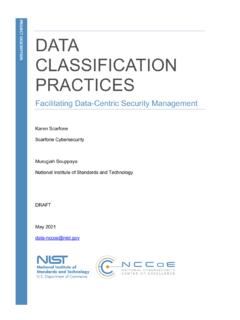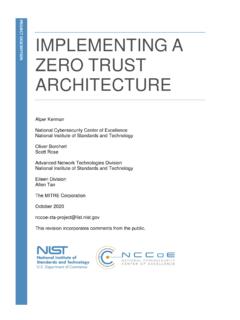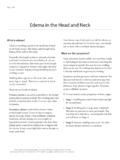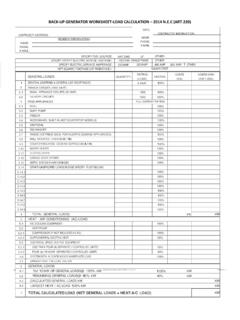Transcription of PROTECTING DATA FROM RANSOMWARE AND OTHER DATA …
1 PROTECTING DATA FROM RANSOMWARE . AND OTHER DATA LOSS EVENTS. A Guide for Managed Service Providers to Conduct, Maintain and Test Backup Files OVERVIEW. The National Cybersecurity Center of Excellence (NCCoE) at the National Institute of Standards and Technology (NIST) developed this publication to help managed service providers (MSPs) improve their cybersecurity and the cybersecurity of their customers. MSPs have become an attractive target for cyber criminals. When an MSP is vulnerable its customers are vulnerable as well. Often, attacks take the form of RANSOMWARE . Data loss incidents whether a RANSOMWARE attack, hardware failure, or accidental or intentional data destruction can have catastrophic effects on MSPs and their customers.
2 This document provides recommend- ations to help MSPs conduct, maintain, and test backup files in order to reduce the impact of these data loss incidents. A backup file is a copy of files and programs made to facilitate recovery. The recommendations support practical, effective, and efficient back -up plans that address the NIST Cybersecurity Framework Subcategory : Backups of information are conducted, maintained, and tested. An organization does not need to adopt all of the recommendations, only those applicable to its unique needs. This document provides a broad set of recommendations to help an MSP determine: items to consider when planning backups and buying a backup service/product issues to consider to maximize the chance that the backup files are useful and available when needed issues to consider regarding business disaster recovery CHALLENGE APPROACH.
3 Backup systems implemented and not tested or NIST Interagency Report 7621 Rev. 1, Small Business planned increase operational risk for MSPs. The Information Security reinforces the need for file back - impacts of data loss events can include one or more ups to enable businesses to resume normal opera- of the following: tions after an event." To help small businesses, and the MSPs that support them, effectively conduct, loss of productivity maintain and test backup files, the NCCoE identified revenue/customer loss capabilities that mitigate the risks identified in the negative reputation and brand impacts Challenge section. Each MSP should consider the business value or dependence it has on the data it controls to determine the appropriate capabilities.
4 In addition, if the MSP is storing customer data (operational or backups), it should take into account any customer data retention requirements. 1. National Institute of Standards and Technology RECOMMENDATIONS (Planning, Implementations, Testing). PLANNING. Planning is an iterative process critical to help an organization optimize and balance costs and operational needs. The following recommendations are based on guidance from NIST Special Publication (SP) 800-53, Rev 4, for controls CP-2, Contingency Planning; and CP-9, Contingency Planning-Information System Backup. When creating a backup plan the following considerations and operational issues should be addressed: Identify the files to back up. Prioritize files based on business value.
5 For example, an organization may not be able to backup all files due to cost, size, or accessibility. Examples of key files are event logs, user files, and applications. See NIST SP 800-53, Rev. 4, AU-9, Protection of Audit information, for more information. {{ Various cloud services may require different backup techniques. For example, the data backup technique for an office collaboration platform may differ from a customer relationship management (CRM) service. In some cases, the data may not be readily available to back up. In those cases, an alternative approach may be required. {{ Customer data files stored by an MSP may need to be backed up. Consider the customer file retention policies and prioritization needs.}}}}
6 Determine restoration time. Establish the desired timeframe to restore files and applications to mini- mize negative impacts to the organization's mission or business operations known as recovery time objective (RTO). {{ Issues that may impact the ability to meet RTO include the internet bandwidth available, any off-site backup facility bandwidth, file transfer limitations and hardware file transfer limitations. Determine file backup timing. Determine maximum age of the backup files to enable operations to be reestablished with minimum acceptable interruption of operations known as the recovery point objective (RPO). Acceptable backup file age may vary based on the file types and business process impacted (operations, human resources, accounting, for example).}}
7 Determine the relationships among systems to understand any dependencies or order of restoration requirements. Determine what set of backup files and OTHER information need to be secured offline and the update intervals that satisfy the RPO and RTO for those files. This data and information may include passwords, digital certificates, encryption keys, and OTHER information needed to reestablish business operations quickly. Plan to save more than one backup file to safeguard your information. (See United States Computer Emergency Readiness Team backup recommendations). {{ To increase the chances of recovering lost or corrupted data, follow the 3-2-1 rule: 3 Keep three copies of any important file: one primary and two backups.}}
8 2 Keep the files on two different media types to protect against different types of hazards. 1 Store one copy or go bag off-site ( , outside the home or business facility). Develop response and recovery processes and procedures that utilize the backup files and backup systems. See Section 5 of NIST SP 800-184 Guide for Cybersecurity Event Recovery for additional recommendations. 2. National Cybersecurit y Center of Excellence Determine the appropriate technical approach to generating backups (automation, manual processes). {{See the Capabilities section below for a discussion of the type of backup technologies that may be considered. {{Printed copies of some data/files may be sufficient as well as secure. Determine workplace relocation options.}}}}
9 Fire, flood, or OTHER catastrophic events could require temporary or permanent office relocation, and not all backup capabilities will be portable. See NIST SP 800-53 Rev 4, SC-37 Out-of-Band Channels, for more information. See offline backup recommendation above. Identify any regulatory and legal data retention requirements such as chain of custody, that may affect the backup plan and technical approach. See NIST SP 800-86 for additional information regarding forensic techniques. {{Be sure to identify customer files/data retention and care requirements, ensuring that those with RPO/RTO and/or specific custody/retention requirements are treated appropriately. Test the planning for recovery for both individuals and the entire organization.}}
10 See Section of NIST SP. 800-184, Guide for Cybersecurity Event Recovery, for plan recommendations. IMPLEMENTATION RECOMMENDATIONS. Integrate the appropriate technologies into the operation (noted in Capabilities and Technologies section below). Keep a set of systems completely disconnected from the business network (offline or on a separate/fire- walled network or located outside the office) for use during a recover/emergency situation. Prepare a Go Bag for data recovery. Keep a copy of critical data including passwords and security keys, in a separate, secure and accessible location to facilitate recovery operations in the event of a data loss incident. Paper copies of some data may be necessary. {{ Be sure to retain credentials for cloud-hosting providers in printed format and/or electronic forms off-site and offline, such as cloud service authentication personal identification numbers, encryption keys and web browser cookies.}}











